
One of Manhattan’s oldest streets was named very early on, in the 1660s, and commemorates the paddle-tailed, dam-building, aquatic rodent whose pelts made up the chief avenue of commerce between Dutch settlers and the already established Native Americans during New Amsterdam’s earliest days from the 1620s through the 1650s, after which sales of beaver pelts fell off greatly.
Nevertheless beavers continued to be much prized for centuries, so much so that the wealthiest man in America during his time, John Jacob Astor, made his fortune on beaver fur, and representations of the beaver are seen in the official seal of New York City (along with a number of other puzzling artifacts that are decoded on this page; and, of course, terra cotta beavers can be seen in the Astor Place station, named for John Jacob.
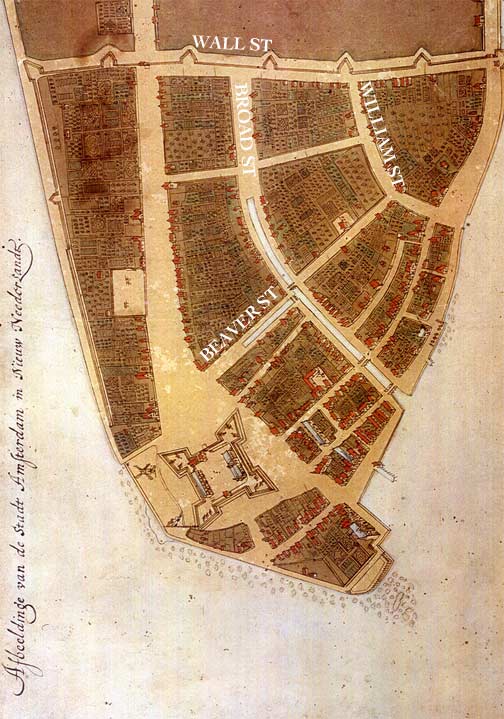
This is the original street plan of New Amsterdam as mapped in 1660: I have helpfully added modern street names. Despite some landfill at both river edges, this street plan, with additions and modifications, is the same one found today in lower Manhattan. In fact the street plan itself has been recognized by the NYC Landmarks Preservation Commission, designated in 1983.
Fort Amsterdam appears at the present location of Bowling Green. If you look closely, you can see individual houses represented on the edges of the streets. At this time, canals still ran on Broad Street and a section of Beaver. There was still an actual wall at the northern end of the settlement, built to keep out those Native Americans hostile to the Dutch, as well as Europeans.
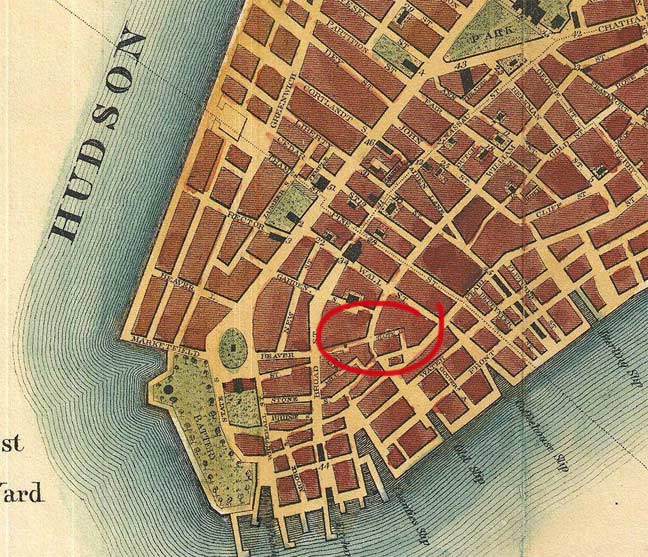
This map of lower Manhattan was produced in 1807. By that time there had been some landfilling, the fort that became Fort George had been torn down, and the street pattern we know today had more or less been established. There have been some name changes (Partition and Fair were combined to form Fulton Street, for example, after Robert Fulton popularized the steamboat.)
 Beaver Street, though, hadn’t attained its final shape. Today the street runs from Broadway at Bowling Green northeast to Pearl Street just barely south of Wall Street.
Beaver Street, though, hadn’t attained its final shape. Today the street runs from Broadway at Bowling Green northeast to Pearl Street just barely south of Wall Street.
However, for much of the colonial era and afterward, Beaver Street ran between just Bowling Green and Broad Street. The block between Broad and William was variously called Prince or Princess Street, depending on spelling and the whim of the mapmaker, and there was just an L-shaped section between William and Pearl.
According to the invaluable resource of Gil Tauber’s Old Streets, this was a short lane called Slote, or Sloat, Street, named for the Dutch sloot, or drainage ditch, which we can guess was pretty much its original purpose. After 1807, Sloat became Exchange and later, Merchant Street. Finally, after 1835, Beaver Street was extended to its present length and the remaining section of Merchant Street was then called Hanover Street.
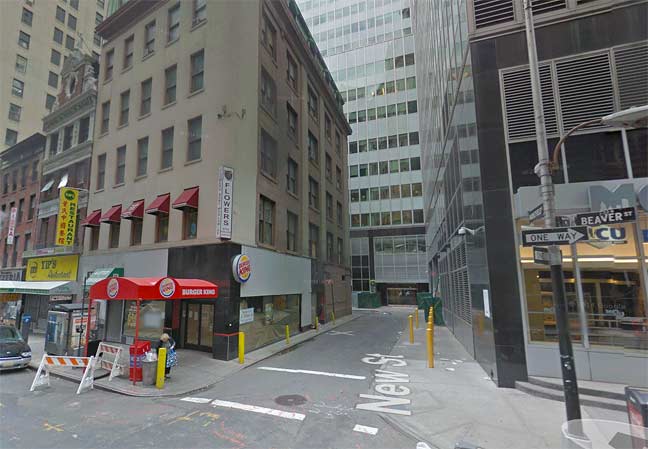
Heading northeast from Bowling Green past massive #2 Broadway, finished in 1959 but given a new sleek exterior in 1999, you immediately see the small alleyway Marketfield Street, which redirects at a 90-degree angle to Broad. Google Maps incorrectly calls it New Street, but that’s an easy error to make since New Street begins a northward run opposite Marketfield.
The street is an English transliteration of the Dutch marktveldt, or “market-field.” Before lawn bowling became a craze in the Dutch colonial days, a produce and livestock market was located at Bowling Green and this street once ran past it, becoming Battery Place further west. After the British took over the street was also occasionally known as Petticoat Lane, a name I wish it had retained.
This stretch of Beaver was once home to NYC’s first synagogue in the colonial era.
18 Beaver Street (at Marketfield Street) caught my eye not only for the old school Yip’s Restaurant sign but what I found on the pediment at the top. It was likely before this particular 3-story building was constructed, but 18 Beaver was once the home of Thomas Williams, scion of the family of “the oldest and largest firm in the world dealing in mahogany and other imported cabinet woods.”
The girl on the pediment is likely Hebe. I am not trying to be insulting — Hebe (pronounced AY-bay) was the ‘cupbearer of the gods’ in classic myth. One of the little details that Beaux Arts architects, who no doubt studied the classic myths in school, provided on buildings to make them beautiful. A trifle, lost from the practices of today.

The building next door, 20 Beaver, is over a century old and has a varied history, according to the former site The Masterpiece Next Door, which sadly has been taken down:
20 Beaver Street looks like a Federal-style (right? Federal?) warehouse. Some net-sleuthing connects the site (and probably the building itself) to the Holmes & Haines cabinetmaking company starting at some indeterminate point early in the 1800s. By 1901, it is home to George A. Kessler & Co.; Kessler was a wine merchant written about in numerous New York Times articles, including one about his escape from the Lusitania disaster and another on a mad expensive $300-a-plate “polar party.” Later it became home to Samuel Lakow‘s custom office furniture business.
While the Lakow office furniture wall-dog ad has been expunged from North Moore and Hudson Streets, Mr. Lakow will apparently have a presence at 20 Beaver for as long as it stands.
I can’t avoid mentioning the Type 1 BC Bishop Crook post on the south side of Beaver Street between Marketfield and Broad. This was an early version of the taller Type 24 Bishop Crooks that have been reproduced by the thousands around NYC over the last 30 years, but this one dates to the 1910s. It’s shorter in stature, has a garland figure around the shaft, and a ladder rest that pays homage to the gaslamps that preceded it. The modern “Mission Bell” light makes it look a bit topheavy, but Bob Mulero got a photo of it when it had an older Bell affixed to it.
The lamp will be hard to see under scaffolding until further notice.
NYC Landmarks has published a handy dandy history of NYC streetlighting, which contains a list of extant poles, though some of them have been demolished despite their being landmarked.
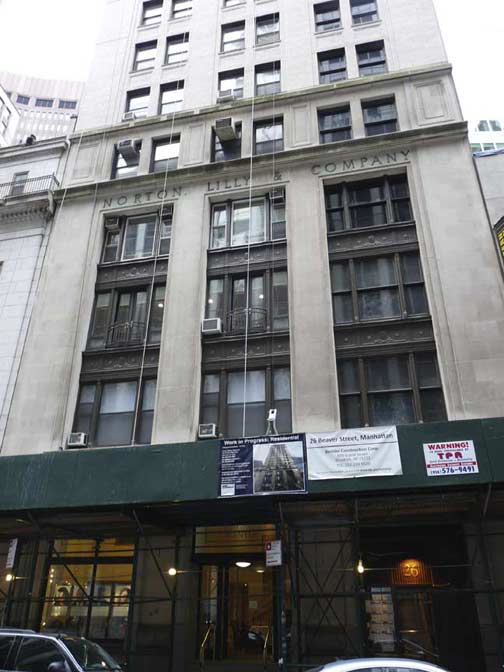
#26 Beaver Street is presently being converted to a residential tower. This used to be the headquarters of Norton Lilly International, a major shipping concern that is still in business, though apparently without an office in NYC. Downtown used to be a center for shipping and steamship company offices; the Cunard Building is nearby on 25 Broadway.
Before my mother worked in Manufacturers Hanover HQ (now JP Morgan Chase) at 4 New York Plaza in the early 1970s (JPMC just sold the building, actually) I seem to remember her working at 75 Broad Street, which became the International Telephone Building shortly after its construction.
It was built in 1929 at South William Street as the headquarters for ITT Corporation, once an international telephone and telegraph giant. During World War II the building was a hub for communications with American submarines operating in the Atlantic Ocean. But ITT moved out long ago, and over the years 75 Broad became a multitenant office building. The building was taken over in default in the late 1980′s, when the future of office properties in the downtown area seemed bleak. NY Times
Amazingly, I hadn’t taken much notice of this massive, stone Ionic-columned and pilastered pile, originally the American Bank Note Company, before. #70 Broad Street was built in 1908 and was once home to the company that produced bank notes currency and stock certificates. The building was purchased by a Chinese investment and construction company from Global Country of World Peace Foundation, which was founded by the late Maharishi Mahesh Yogi (who came to prominence as the Beatles’ guru in the 1960s). It had become a prominent center for the study of Transcendental Meditation. American Bank Note had sold the building in 1988.
Another massive bank note building in Hunts Point, Bronx, was developed as luxury housing about a decade ago.
Passing Broad Street, at #44 on the south side of Beaver is what was originally the Kerr Steamship Company Building, which has kept some nautical motifs despite its present status as HQ for the NYC Sanitation Department. Kerr Steamship built the Rochester, the first Allied vessel to successfully challenge the German blockade during WWI, reaching Bordeaux, France. The building was completed in 1920.
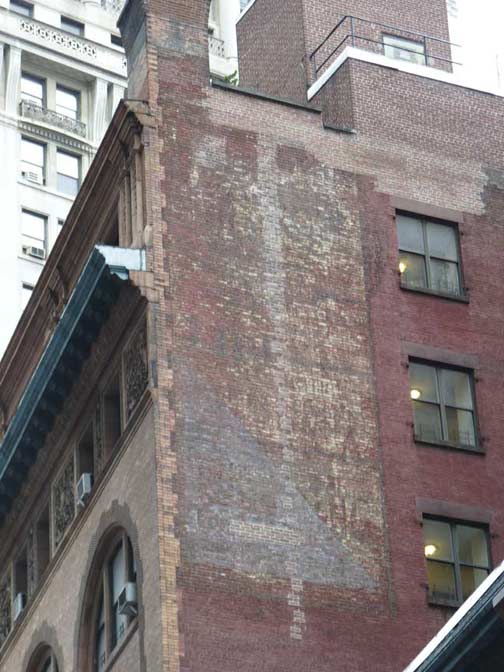
A long-faded painted ad appears on the back end of the building I’l be discussing next. A better preserved one is also discussed below.
South William Street curls north from Broad Street to the intersection of Beaver and William, creating a pair of virtual triangle-shaped plots, the better to build two unusually-shaped buildings. The first of them is the famed Delmonico’s Restaurant building at #56 Beaver, a Renaissance Revival tower completed in 1891. Swiss immigrant brothers John and Peter Delmonico opened a pastry shop on William Street in 1827, and their restaurant opened in this location in the late 1830s, becoming a massive success. At its height the restaurant had ten branch locations, with the flagship located here. The original Delmonico’s went out of business in 1919, with other restaurants taking the famed name for nearly a century after.
On this FNY page, I noted that the history of Delmonico Place in Bedford-Stuyvesant, Brooklyn, was connected to a farm the brothers owned in what was then the hinterlands.
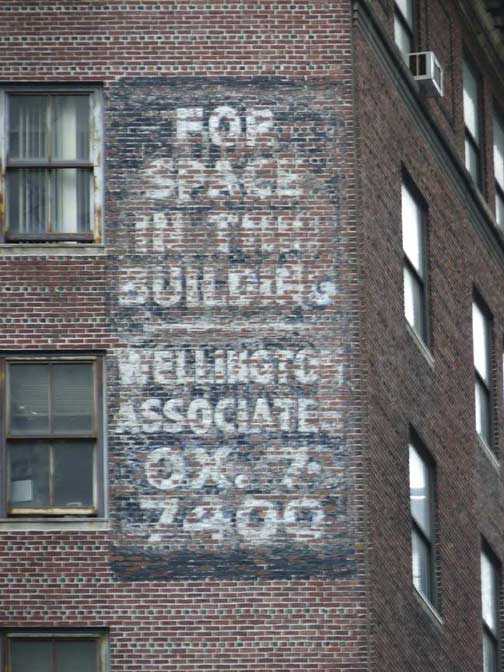
This painted ad on #44 Beaver can be seen looking west on Beaver Street from Delmonico’s. The OX exchange stood for OXford.
The second Renaissance Revival, Flatiron-ish tower at this junction is One William Street, originally the J.W. Seligman & Co. Building, constructed in 1907. It is the current USA home of the Italian banking group Intesa Sanpaolo.
The new addition to this 5-cornered intersection is 15 William, also known as the William Beaver House, a new residential tower opened in 2009. For most of its history, there were never many people actually living in the Financial District, but developers realized there was a market in developing older office buildings as well as tearing down older buildings in favor of towers like this one.
The AIA Guide to NYC labels it “the Post-It Note Building” because of its rectangular yellow panels that help to liven up its otherwise dull gray exterior. According to the Guide, the apartment building boats 24-hour room service, a private movie theater, an indoor dog run, and an on-site auto mechanic.
The current ad campaign pitches it to families. (Financier families.)
#3 Hanover Square’s back edge faces the southeast corner of Beaver and William. Traces of the building’s old role as the home of the New York Cotton Exchange can be found on its exterior. It’s one of the oldest commodities exchanges in NYC (founded in 1870) and has occupied a number of downtown buildings, including #1 and #3 Hanover Square (the latter was built in 1922). It was a tenant at #1 World Trade Center when it was destroyed by terrorists in 2001. NYCE merged with other commodites exchanges in 2004 to form the NY Board of Trade, which is presently located in the newest NY Mercantile Exchange Building.
20 Exchange Place was constructed on William Street between Beaver Street and Exchange Place in 1931 for the merged National City Bank of New York and the Farmers’ Loan and Trust Company, which decades later evolved into Citigroup. It’s a 57-story Art Moderne tower with touches like large coins on the sides of the building and large, staring heads looking down on the street from the 20th floor. The 16th through 57th floors are being converted to residential use called Twenty Exchange.
Scouting New York, run by a movie location scout who is able to gain access to many buildings closed to the public in his work capacity, has several interior scenes at #20 Exchange, including the original mural from the bank, and several photos of the door, now hidden under scaffolding, which has fantastical Moderne representations of planes, trains, steamships, hot air balloons and other means of transit. He also has good close-up shots of the exterior coins.
Once again, the scaffolding is there… until further notice.
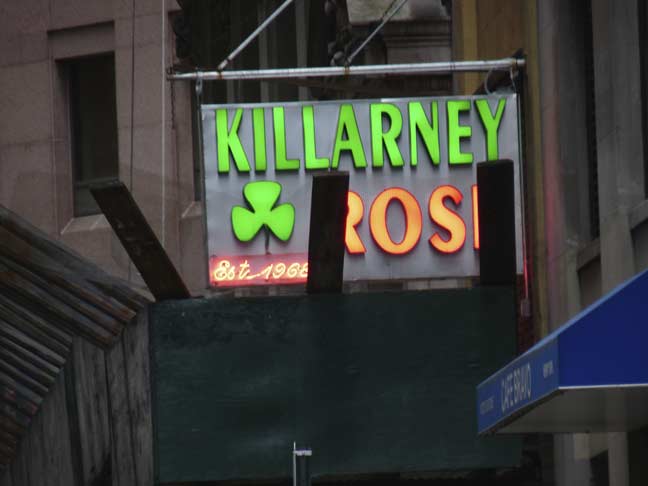
Killarney Rose has been serving beers, shots and the occasional lunch on Beaver Street since 1968, as the neon sign indicates. Ever-present scaffolding can’t completely obscure the sign. Killarney is a small town in County Kerry, Ireland. Its name is derived from an Irish Gaelic term meaning ‘church of sloes’, a sloe being a blackthorn plant from which a variety of gin is derived.
The sign is in the sanserif Peignot (“PEN-yo”) font.
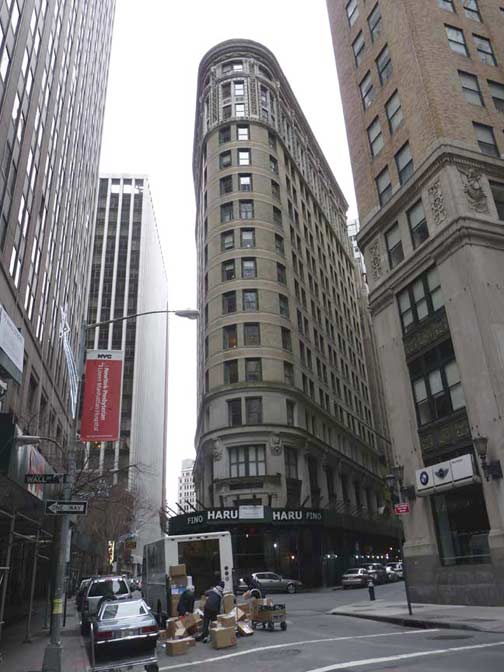
Finally, one more “Flatiron-esque” building, #82-92 Beaver at the northeast end on Beaver Street at its sharp junction with Pearl just south of Wall, is the Beaver Building, which began as the Munson Steamship Co. building and later the NY Cocoa Exchange Building, cosntructed in 1904, about the same time as the Flatiron. Recently it’s been given the odd address #1 Wall Street Court. It isn’t on Wall Street but in plain sight of it, and developers wanted to give it a cachet to attract residential buyers.
Munson Steamship owned the building until 1921.
1/11/15

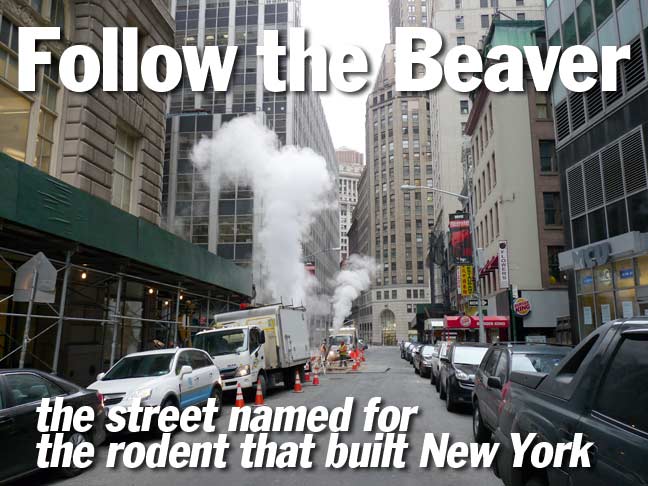
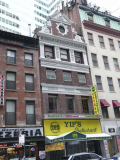
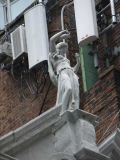
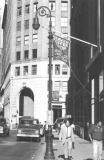
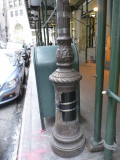
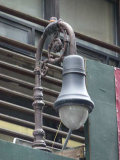
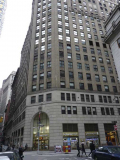
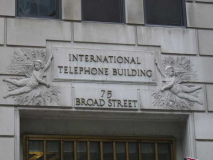
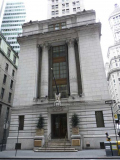
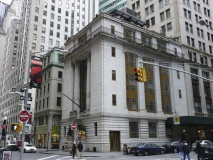
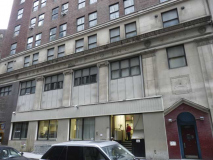
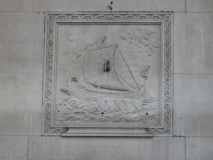
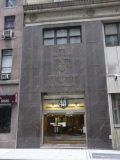
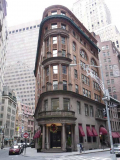

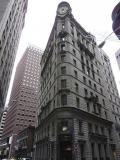
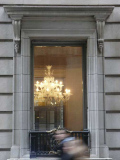
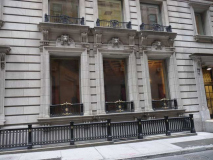
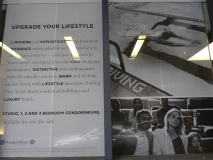
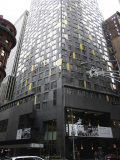

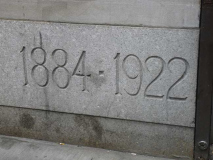
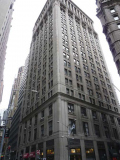
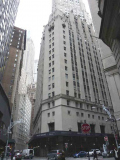
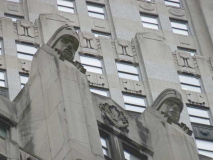

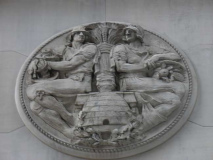
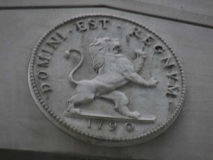
23 comments
It was weird walking through the vast empty Cunard building lobby in the early 70s…your footsteps
echoing
You missed the “REVS” rolly!
what is revs
Miss Hebe atop #18 Beaver looks like she belongs on the Maine monument at the S/W corner of Central Park ?
Correction: 26 Beaver Street is not “presently being converted to a residential tower.” It was converted to a co-op in 1980, one of the first conversions in FiDi. 19 stories, 21 apartments–all but 2 floors are full-floor apartments. The scaffolding is just for façade maintenance.
Barrett DiPaolo – who has a beautiful loft at 26 Beaver Street – correctly notes that this building was filed with the New York State Attorney General’s Office for Co-Op conversion in August, 1980 by its sponsor Neil Joffee. Neil and his son were attorneys involved in many wrap-around mortgage financed coop conversion plans in the 1980s.
Prior to its conversion the building was known to those of us in the downtown arts scene as an ‘artists building,’ and among its earlier inhabitants was Jeff Koons when he was working as a sales-clerk at the MoMA. Another earlier settler was the art couple, critic and poet, Carter Ratcliff and Phylis Derfner. Pre-9/11 the downtown residential scene was far sparser and edgier. Old Slip, Stone Street, Fulton St. and their dilapidated buildings huddled in the shadows of the Wall Street towers. More often than not those living there were illegal pioneers or AIR protected.
Among the other luminaries of the 1980s was the flamboyant Oribe Armoando the cuban hairdresser to Madonna. He frequently worked with another fortunate early investor in loft real estate Steven Meisel (see 190 Bowery).
Today, 26 Beaver is one of the oldest established residential coops in the Financial District.
Marketfield Place was provided with the petticoat association by the British because it was the site of unauthorized commerce that nourished sailors the world over.
Adjacent to the Marketfield Place on the Broad Street side is the verso side of the modernist 2 Broadway, which boasts two little known mosaics by the abstract expressionist Lee Krasner. The other four panels of her mosaic are on the Broadway side fortunately for their longevity, they are in the canopy overhang and shade of the Brutalist facade, unfortunately, this has impaired their aesthetic visibility along with the usual street architecture of traffic lights.
The original Delmonico’s Restaurant was burned down in the Great Fire of 1835 – the rebuilt version there today claims that the two columns in its entrance area stood originally in the volcanic ruins of Pompeii and were recovered as a talisman to how early Manhattanites experienced the fire of 1835 – which triggered a cycle of rebuilding and land speculation in the ‘conceptual’ undeveloped lots first surveyed by the Randal grid 1807-1811. Delmonicos became a forerunner of the franchise and their luxury dining establishments appeared on 14th Street and 26th Street and 5th in progress and step with the upward march of prosperous diners.
Two other forgotten notes, the New York Consolidated Stock Exchange headed by Ogden Budd was at the corner of Beaver and Broad in 1901-7. The American Banknote Building – printer and engraver to most of the stock certificates in America also stood immediately to the North of 26 Beaver Street, and today houses the transcendental meditation world peace library and administrative offices, which also occupy the ground floor of 26 Beaver Street.
i think everyone that lives on the beaver street needs to own a bbeaver
Just curious, I have a single fold publication dated 1827 titled “the medly or the Saturday’s comical amuser” that has the address of 60 beaver street. a weekly paper that could be subscribed to for two shillings per quarter. Can you tell me anything about it or the address it was located?
At your service,
David
My Wolfe family Richmond va had sons udolpho & Joel importers of Schnapps at 44 Beaver St. c. 1850
My grandfather owned a Bar, during the 1940’s on Beaver street, called the Beaver House. I wonder if anyone remembers it.
A relation of mine was Manager of a Light Storage Company (Sellers?) based at 16 Beaver. Anyone know anything about that? Best, Brian
75 Broad was the Cosmodemonic Telegraph Company in Henry Miller’s Tropic of Capricorn.
I have an antique desk I inherited from my great grandmother
that has a gold plate on it that says,Pearl Desk Co. Whitehall 8736 2 Beaver St. NY..I have tried to research about this desk and find anything. Does anyone know anything about a furniture store being there back then?
Dear Sir’s, I am just reading a couple history. I live in Finland and just look one old letter (which I, stupid gay, write to my computer from the origínal letter of my old seaman. Originally he was escaping from his home at Turku in Finland to the sea. He was living couple years at Liverpool in England. In his letter dated 12th September 1894 he has written his last address ” Mr. H (Henrik) Gillen, 53 Beaver Street between Brood & Williams New York America USA”.
I’ve find just this information of the Beaver Street and I’m very very interested a lot of more about it. I’ll ask: “Could somebody perhaps help me a little bit more information to find and tell ( by email) if there is still some old building in the given address”. Sincerely Pekka E Tuhkanen, Raahe Finland, email: evertp.tuhkanen(at)gmail.com
Does anyone recall the now defunct “Kansas City Meat Exchange ?” Located at 20 Beaver Street in the early to mid 1980’s. I can find no information on-line about it.Used to go there for lunch and it was always crowded ! It was a fast-food place that served giant beef hamburgers with sauteed,smothered onions,wrapped in foil for ! 2.49 and huge bags of delicious steak fries for $1.49,They were served in brown paper-bags to go…greasy,salty and so delicious ! I loved the food there and was only 25 in 1982 and simply can not eat that way (often) today at 63.Sadly,it’s a place that seems to have been lost with time.
Yup, I remember the Kansas City Meat Exchange. Exactly as you describe it – big greasy burgers and fries. Went once a week back in the early 80s. It was a bargain.
Me, too. I was lucky enough to stumble across the KCME on a rare visit to the Wall St area in ’84(?). Can’t remember the price (I know it was cheap) but enjoyed a beautiful little boneless rib eye sandwich.
OMG, like butta…;-)
I came across this site during a search for information about the Dutch period of New York City’s history. My ancestor, Dirck Gorisz Storm, was issued a license to open an inn in the house he rented from Symon
Jansen Romeyn on “the Bevergracht” (Beaver Street) in 1665. The map drawn by the author of the source for this information shows the house several lots northeast of Beaver Street’s intersection with the street that
became Broadway (“De Heere Straet”). I’d welcome contact with other members of Dirck’s family.
Source: Storm, R. W. (1949). “Old Dirck’s book: a brief account of the life and times of Dirck Storm of Holland, his antecedents, and the family he founded in America in 1662”. [New York?: s.n.].
(pg. 53 of 402)
Gary, I just discovered this site as well and found information on another site called “Hudson-Mohawk Genealogical and Family Memoirs: Wendell. My ancestor, Evert Janzen Wendel (now
Wandall) came to New Amersterdam in 1640 and obtained a patent for a lot in what was then called the “Graft” (now Beaver Street, NYC.) He left there in 1647 to Fort Orange (Albany)
Hello Cousin,
Are you Gary, my1st cousin son of Kenneth or a more distinct cousin. I am of the Peter/Pieter Storms line.
My parents met at the Beaver House in the 1950’s can you tell the actual location.
Joe Bass had a cigar stand in the lobby of the cocoa exchange at 82 Beaver Street back in the 1970’s . Great guy, does anybody remember him?